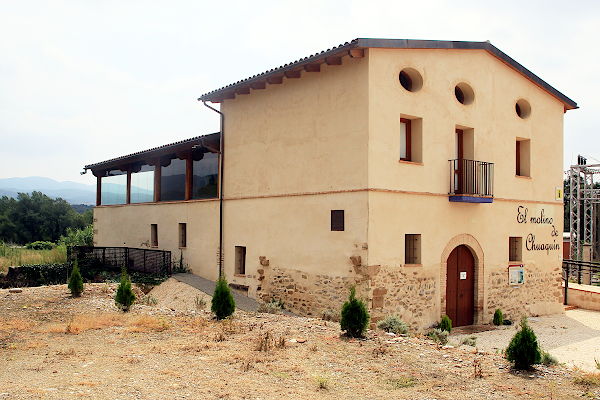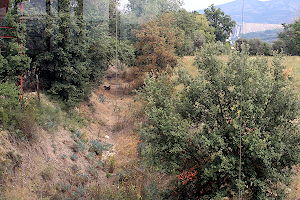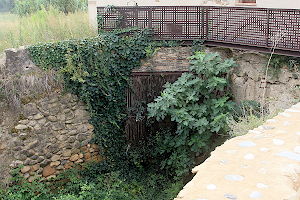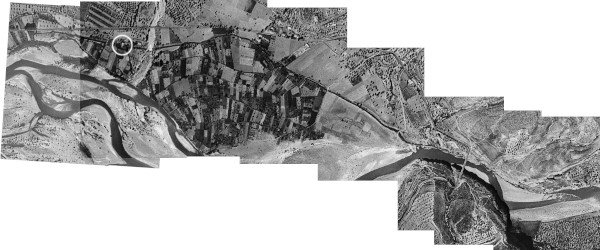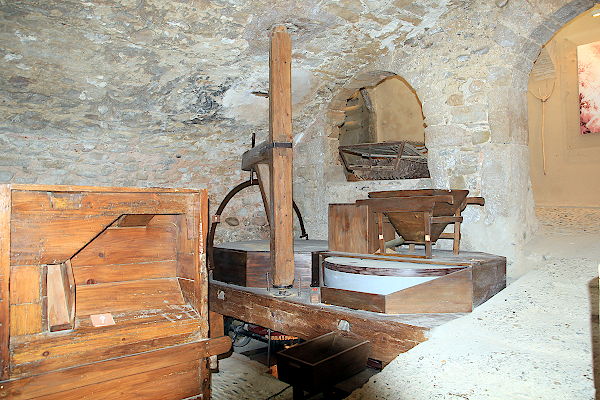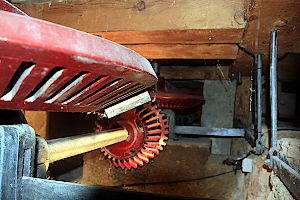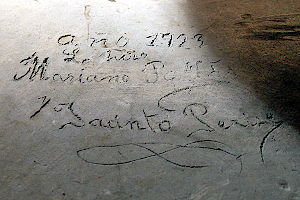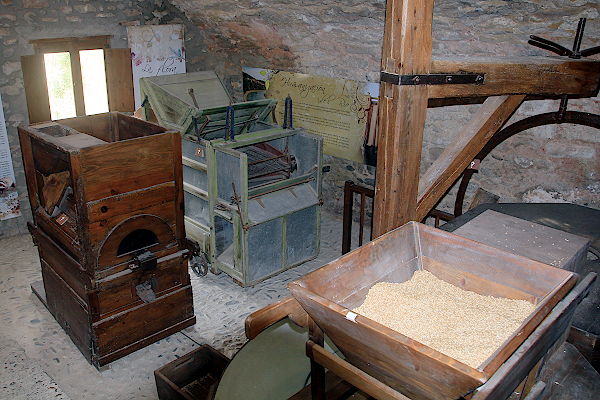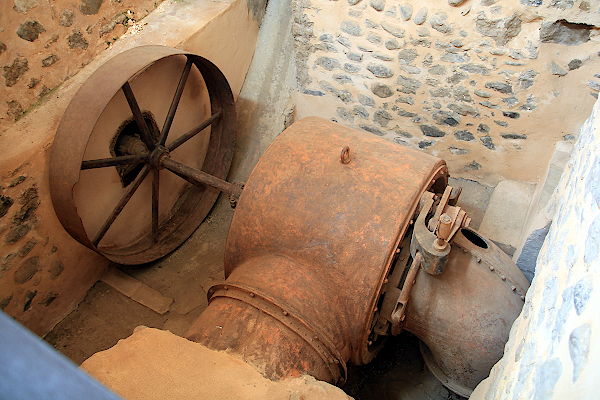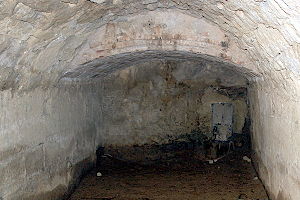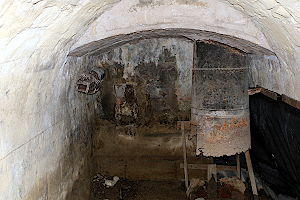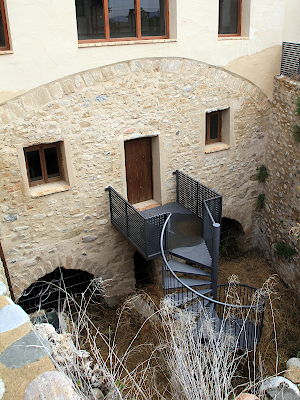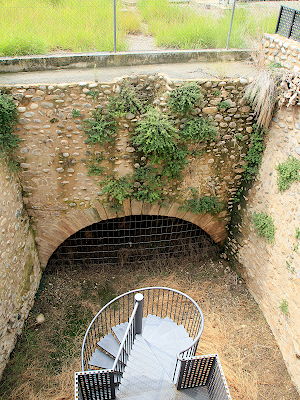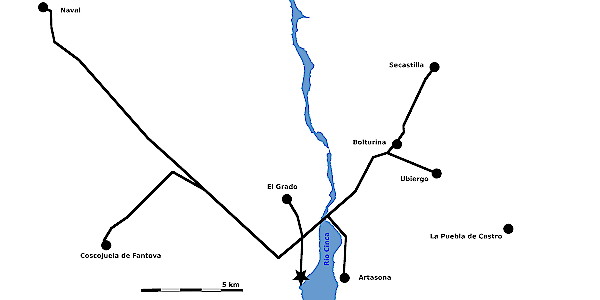Mills in Alto Aragón - harinero, central eléctrica
El Grado
El Grado is situated a bit besides the main road between L'Ainsa and Barbastro.
The mill is situated along the east side of the road a bit further south than the Barrio del Cinca (with fuel station) of El Grado.
The construction, which also houses the local tourism office, is signposted and there is ample parking space. It may be difficult to
hit a time when it is open, though. The mill got the name
molino de Chuaquín in honour of a
former mayor of the village. The upper floor
of the building is dedicated to
parchís (a board game) of which El Grado is the world's capital, we have learned.
Pictures: 20.VIII.2014
There is no way that the installations will
run again — not even in demo mode — like in some other mills that were restored
(e.g.
Buera,
Caldearenas,
or
Troncedo). Most elements of the milling business
were preserved, however, and a visit is still worth its while even though I couldn't discover anything
relating to the production of electricity.
In the early years, at the beginning of the 20th century,
the back half of the construction was lower than nowadays and counted only one floor: it was the mill proper where the
stones and the turbines were housed. Later on more floors were added.
The canal is an impressive piece of work (4). It is broad and deep
and runs for more than 2 km along the river Cinca. The intake can be seen as the
funnel like structure at the far right in (4) and is nowadays below the waters of the embalse de El Grado.
The canal runs for more than half of its length along the
high end of a zone with many small patches, probably vegetable gardens. Just before reaching the mill
the canal has to take one last obstacle, a narrow tributary of the Río Cinca: the Barranco de
Lariño (
⋕). This rivulet is crossed by means of a siphon.
The mill was owned by
Celso Joaniquet Ponz (
†,
§).
He was born on the 21st of July 1884 in Bono, a village in the Pyrenees on the border between Aragón
and Cataluña, studied in Barcelona and worked in Madrid.
He was a very active lawyer and had a remarkable view on the future of Spain and
Europe. In January 1931 (!) he held a much applauded speech in which he discussed the need for
a European Union as the only effective remedy to save the European industry from the crisis at that moment.
Only by eliminating customs barriers would Europe be able to retain intercontinental markets, he said
(♠). He wrote several books about politics and economy.
In the 1940's the Spanish court started an investigation against
him. There were indications (coming from trustworthy sources, the file says) that he was incurred in political
responsibility under the law of 6 february 1939 (
§).
This
Ley de Responsabilidades Políticas was used as a tool for
punishment of people who defended the
Republic. The law was, however, not only used to suppress the Republicans
who were most influencial or most rich. It was also applied to those who had
escaped Franco's courts-martial because they were not liable for any criminal act.
The law became a repressive instrument that allowed the settling of accounts with
the families of Republicans (
¶). The case against Joaniquet was dismissed 17 years later in 1957 (
§).
Joaniquet (or his wife) was the owner
of several mills in the region (
§):
the mill of El Grado (house and power station),
a mill in Enate (house, power station and mill for fodder),
and a mill situated in
Guaso (grain mill and power station).
The electricity business operated through corporations.
In El Grado it was Riegos y Fuerzas del Cinca and in Guaso it was
Fuerzas Eléctricas del Ara.
Old maps (
‡) show power lines
of the mill of El Grado to all the villages in its
neighbourhood: Artasona, Bolturino, Ubiergo and Secastilla to the East and El Grado, Coscojuela de Fantova
and Naval to the West (14).
The grid was extended to Castillazuelo
(see
† and our page about
the mill of
Huerta de Vero). That should have been in 1929, but the maps of 1931 show no lines.
The editions of 1952, however, show so many lines that it is difficult to see what lines
brought the power from El Grado to Castillazuelo.
† José Antonio Cubero Guardiola — 2012 — La electricidad en Castillazuelo, apuntes sobre su historia.
in ro Zimbeler de Castillazuelo
— Revista informativa de la asociación cultural "Castillazuelo"; Num. 24, Jan. 2012, pp. 28-29.
‡ Based on maps of the
Instituto Geográfico Nacional
of Spain, series MTN50, leaf 250, 288, Ed. 1952
☨ The aerial photographs were taken during
what is called the El Vuelo Americano serie B which happened between March 1956 and September 1957.
The work was done by the American Army Map Service. © Instituto Geográfico Nacional de España
⋕ I am using the name shown on the older maps of
the IGN. Newer editions from 2003 on show the rivulet as Barranco de Ariño which is probably
born out of a confusion with a barranco with this name situated a few kilometers to the South, near Enate.
§ Archivo Histórico Provincial de Huesca J/005771/000009.
¶ Fernando Peña Rambla — 2012 —
La exigencia de responsabilidades políticas como mecanismo represivo especial: la Serratella (Castellón), 1939-1942.
Millars, XXXV (2012) pp. 172-197.
♠ ABC (Madrid) — 27.I.1931 — En la Casa de Aragón. Ed. de la mañana, p 37.


